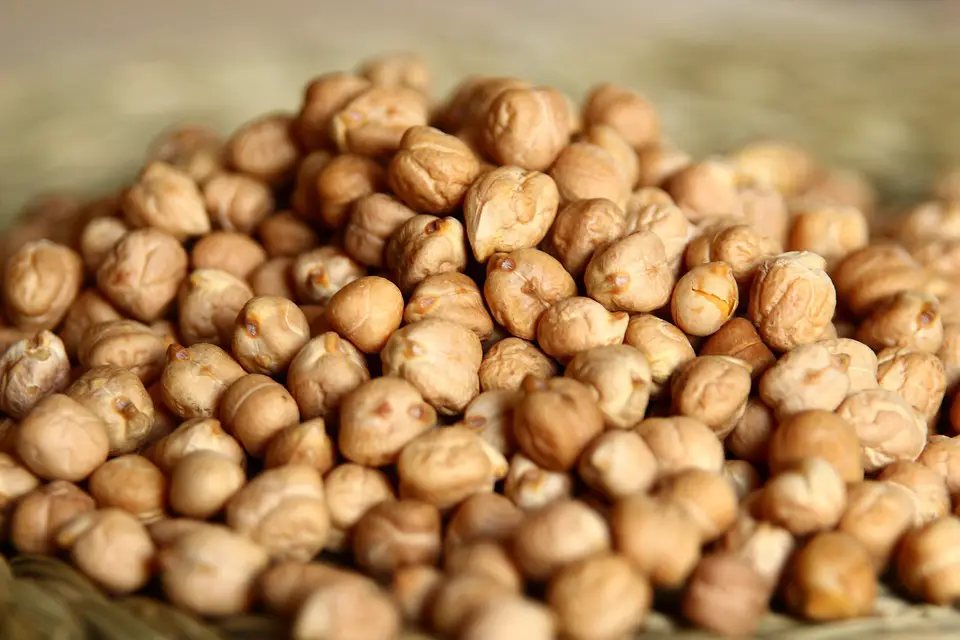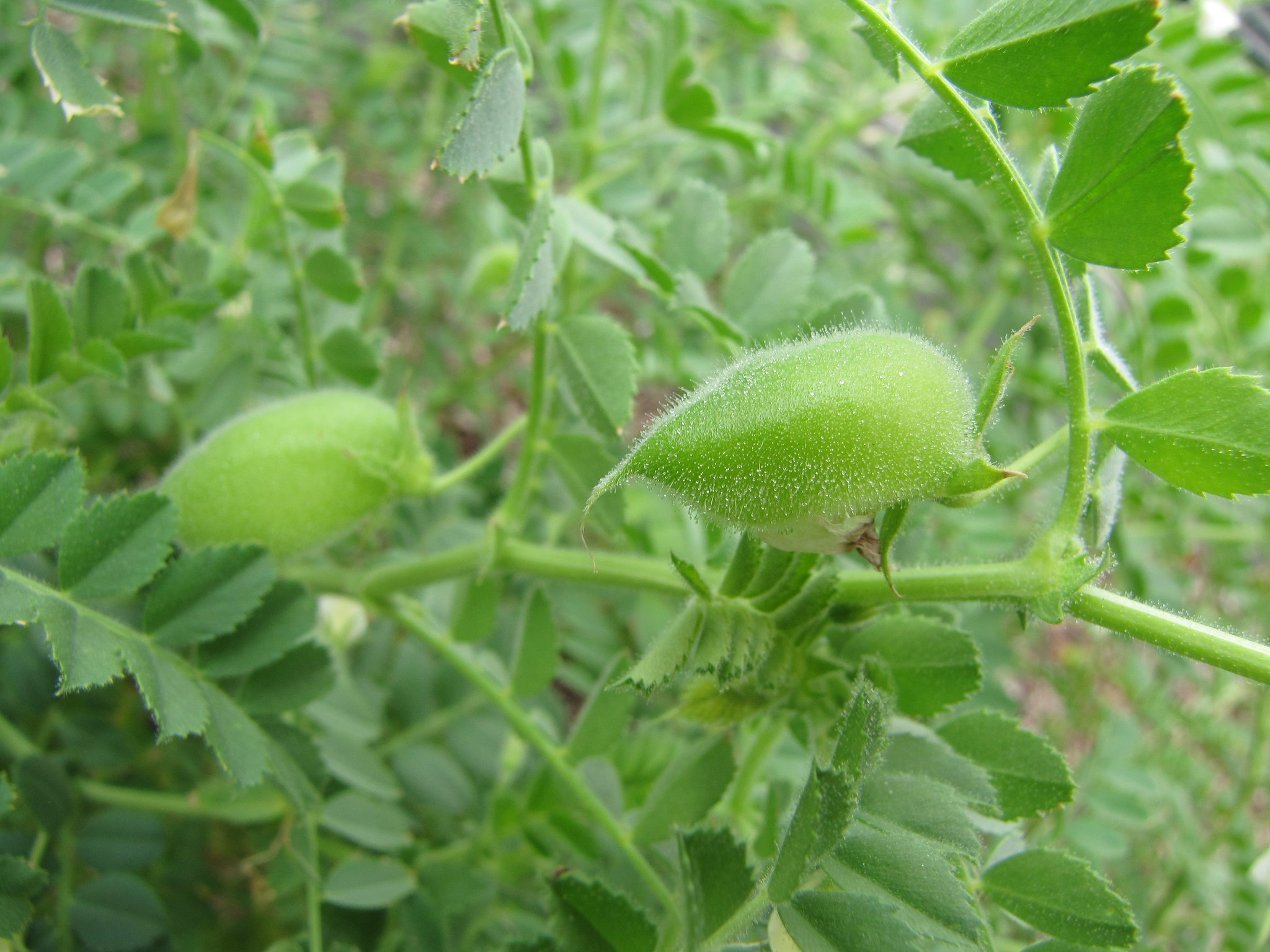We use affiliate links to run our site. When you buy through links on our site, we may earn an affiliate commission, without any added cost to you. Learn more
Chickpeas are also called Garbanzo beans. These are full of protein and very nutritious and have a nutty flavor. The following information on growing chickpeas will help you start growing your own.
Growing chickpeas is fairly easy. In ideal growing conditions, the seeds would sprout within 10-14 days. Take a little bit of care like protecting the shallow root system, watering regularly, etc, and within 100 days your chickpeas will be ready to harvest.
But although growing chickpeas is easy, most gardeners are not aware of how to do it. So today we will discuss how to grow chickpeas.
Some Facts and Information About Chickpeas:
- Chickpeas are native to India, the Middle East, and areas of Africa.
- They are also called garbanzo beans.
- It is an annual grain legume or “pulse” crop sold in human-food markets.
- Chickpeas have a deeper root system than dry peas or lentils.
- They are more drought-tolerant if there is subsoil moisture.
Different Varieties of Chickpeas:
There are 2 main varieties of chickpeas that are cultivated. Kabuli and Desi. You can easily spot the difference between Kabuli and desi chickpeas by the color of their flowers.
Kabuli chickpeas have white flowers, whereas the desi variety has purple flowers. Kabuli variety is also slightly taller than desi chickpeas.
Kabuli seeds have white to cream-colored seed coats, whereas the desi ones have a brown seed coat and smaller seeds.
Before selecting the chickpeas variety to grow, always consider things like time of maturity, growth habit, seed size, and color pattern etc.
How To Grow Chickpeas From Seeds:
The best way to grow chickpeas is from the seeds. They do not do well in transplanting. Sow the seeds directly in the soil.
Growing Chickpeas From Store-bought Chickpeas
You will find chickpea seeds or dried chickpeas at any grocery store. You can easily grow chickpeas from those store-bought ones. Buy a bag of chickpeas, soak them for 4-5 days, check how many of them have sprouted, and plant them in the ground. If the chickpeas are too old, they might not sprout at all. In that case, try with a different set of chickpeas.
Where to Plant Chickpeas:
Plant chickpea into a small-grain stubble. Never use a field that was planted to dry pea or lentil in the last two years. This will minimize the risk of any root rot for the plant.
Add aged compost before planting. Don’t plant chickpeas where green manures have just grown. The green manure has a high amount of nitrogen, which will result in green leafy growth and a lack of seed production.
How to Plant The Seeds:
Sow seeds at a depth of one inch. Give a space of 6 inches between two seeds. Keep a gap of 18 inches between two rows.
For Kabuli variety, make sure you never exceed four established plants per square foot. This will ensure maximum seed size.
Water the seeds well and continue to keep the soil moist, not sodden.
Ideal growing environment for Chickpeas:
Ideal pH:
The ideal pH for growing chickpeas is 6.0 to 8.0.
Sunlight:
Chickpeas need full sun for at least 6 to 8 hours. Although they can grow in partial shade, the yield will be reduced dramatically.
Temperature:
The ideal temperature for growing chickpeas is around 70 to 80°F. At the time of flowering, they can tolerate an even higher temperature.
Chickpeas are not very good at tolerating low temperatures. Make sure the surrounding temperature never falls below 60°F when you grow chickpeas.

Ideal Soil for Growing Chickpeas:
The ideal soil for growing chickpea is fertile, sandy, loam soils with good internal drainage. If the drainage is not good, it can increase the chances of diseases like root and stem rot.
You can increase the drainage of the soil by adding coco coir, peat moss, or compost to the soil.
Taking Care of Your Chickpeas
How to Water Chickpeas:
Keep the soil evenly moist until chickpeas have pushed through. Water regularly during flowering and pod formation.
Too much water can cause flowers and pods to fall off. To conserve water, use mulch. It will also help you combat weeds. Read more about mulch in this post.
How to Fertilize Chickpea Plants:
Chickpeas need lots of potassium and phosphorus for their growth. Being a legume, they can take nitrogen from the air, so you don’t need to worry about adding nitrogen to your fertilizers.
Use a soil tester to first find out the current situation of your soil. Once you find that out select your fertilizer accordingly.
Use a good mixture of composting ingredients to make compost. If you are buying compost, make sure to select a good one.
Mix compost with soil before seeding chickpeas.
When to Harvest and Store:
Within 100 days after sprouting, your chickpeas will be ready for harvesting. They are best when they are still green. You can eat the peas directly off the vine.
If you are planning to get dry seeds to wait till the pods turn brown. Pull the pods off the plant. The pods will split easily, exposing the seeds inside. Each pod has one to three seeds inside.
As the plant continues to produce fruit for some time, your harvesting season can continue for several months after planting before the frost comes.
Take care while harvesting chickpeas. The pods have spiky ends that can cause pain to fingers if they slip inside the fingernails. Use gardening gloves for protection.
You can keep fresh chickpeas for up to a week in the refrigerator. Dried chickpeas, on the other hand, can last up to a year if you keep them in a cool, dry location.

Weed Management of Chickpeas:
Chickpeas do not compete very well with weeds. Weeds like Kochia, Russian thistle, wild mustard, and wild buck can cause major problems in chickpea cultivation.
So you need to give weed management a priority. We have a detailed post on how to control weeds organically. See it for more information.
Pest and Diseases of Chickpeas:
Some of the common pests of chickpeas are
Cutworms:
Many species of cutworms feed on chickpea plants. They create most of the damage from late May through mid-June. A mature cutworm larva is about 1½ inches long, and its width is similar to a pencil.
Larvae will cut young plants in the seedling. In severe cases, they can even destroy the entire crop production.
Search for freshly damaged plants. Then dig 3 or more inches around those damaged plants to see if you find any cutworm larvae. Then manually remove the worms.
The best time to do this is in the evening, as cutworm larvae are very active at that time.
Wireworms:
The mature larvae are hard, smooth, slender, wirelike worms. They are yellowish-white, 1-2 inches long. They feed on the germinating seed and young seedlings.
The damaged plants will wilt and soon die. In severe cases, a large portion of the crop gets damaged you might have to sow the seeds again.
Grasshoppers:
Adult grasshoppers and nymphs feed on the green parts of the plant. This creates holes in leaves and pods. The greatest risk from grasshopper feeding injury is in the bud stage through early pod development.
They also consume flower buds and small pods, resulting in a loss of yields.
Some of the most common diseases of chickpeas are:
Seed Decay and Damping-off:
Chickpeas, especially the large-seeded Kabuli types, are very prone to seed decay and damping off. The pathogens that are responsible for these diseases are Pythium and Rhizoctonia.
Some of the common symptoms are
- Poor emergence due to seed rot,
- Damping-off of seedlings and
- Root rot.
One of the solutions to avoid this problem is to plant your chickpeas in warmer and drier soils.
Ascochyta Blight:
This can cause complete loss of crops even in fields with no prior history of the disease. Ascochyta blight is caused by the fungal pathogen Ascochyta rabiei.
This fungus is specific to chickpeas and does not infect other peas or lentils. The blight first appears as a small gray spot and then quickly becomes brown lesions with dark borders. The disease can affect stems, leaves, pods, and seeds of the plant.
Here are some steps you can take to prevent the disease.
- Plant disease-free seed.
- Practice long crop rotations.
- Select chickpea varieties with reduced susceptibility. Some varieties are less susceptible than others.
Foliar Diseases:
Foliar diseases for chickpeas include Sclerotinia stem rot and Botrytis gray mold. The stem rot generally has only a moderate impact on chickpea yield, but in the case of gray mold can cause total crop loss.
Companion Planting With Chickpeas:
Chickpeas are a member of the legume family. As you know, legumes are a very good companion plant for many plants. They can fix nitrogen in the soil and thus help other plants. Grow chickpeas with carrots, beets, cucumber, and celery.
They are also a good companion for plants like eggplant, strawberries, radish, potatoes, and many more. Don’t plant chickpeas with plants like onions, garlic, leeks, etc.
Chickpeas as A Cover Crop:
Being an annual legume, chickpea is a great cover crop for many plants. You can increase the yield of any cereal crop by planting chickpeas in the garden.
Uses of Chickpeas:
Green chickpeas don’t need much cooking. You can eat the seeds like any fresh vegetable. The dry seeds are good for cooking different recipes. The seeds are sold either dry or canned. Chickpeas are high in folate, manganese, and rich in protein and fiber.
Amazon and the Amazon logo are trademarks of Amazon.com, Inc, or its affiliates.

Hi there! My name is Prasenjit and I’m an avid gardener and someone who has grown a passion for growing plants. From my hands-on experience, I have learned what works and what doesn’t. Here I share everything I have learned.
